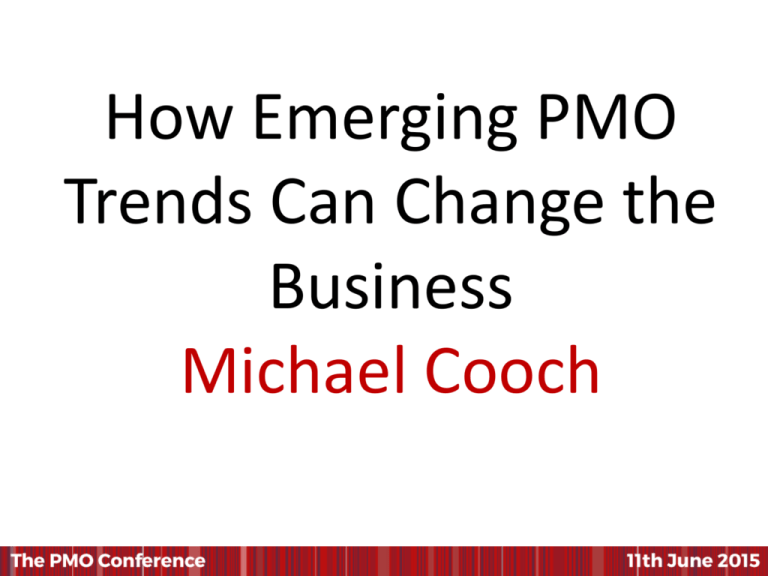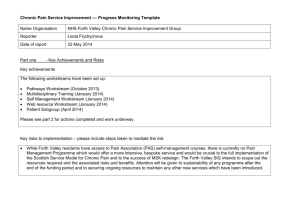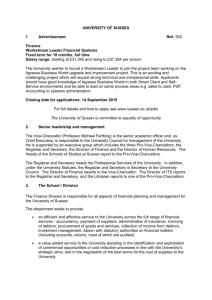
How Emerging PMO
Trends Can Change the
Business
Michael Cooch
Online Polling – joining instructions
We will be using an interactive online polling tool in today’s session.
To join the poll, either:
Log in via web browser
• URL:
PollEV.com/pwcppm
Use your mobile phone
• Text pwcppm to
020 3322 5822
The emerging importance
of ‘intelligent’ PMOs
How Emerging PMO Trends Can Change the Business
Michael Cooch
The PMO Conference, 11th June 2015
Objectives for the session…
• Identified challenges for our PMOs
• Discuss how the PMO should evolve to
become a trusted advisor
Challenges for the PMO
What are the key challenges facing PMOs?
In low-performing organisations executive
sponsorship is approximately 60% less
likely to have an appreciation of the strategic
value of a PMO.
In low-performing organisations PMOs face
much greater difficulty in being accepted
as a real value-adding proposition, at all
levels of their organisation, when compared
to high-performers.
In low-performing organisations PMO
staff are much less likely to have
formal project management
qualifications, hands-on-experience and
extensive project management
knowledge.**
In low-performing
organisations project
management performance (and
PMO performance) is not
measured nor is appropriate
accountability for outputs
assigned.
A project staffed with uniformly
very low-rated personnel on all
capability and experience
factors would require 11 times
as much effort to complete
the project as would a project
team with the highest rating in
all the above factors.***
*Source: The State of the PMO, A Benchmark of Current Business
Practices, Center for Business Practices (CBP) Report
**Source: The State of the PMO, A Benchmark of Current Business
Practices Center for Business Practices (CBP) Report
***Source: Software Engineering Economics, Prentice Hall, Englewood
Cliffs, NJ, p431,Boehm B
What is our collective experience?
How would you characterise the maturity
of your PMO?
Our own programme data shows that less than 1%
programmes are optimised.
Absent, 11%
Optimised,
0.4%
Mature, 14%
Ad-Hoc, 11%
Organisations could
substantially benefit
from improving the
maturity of their
PMO.
Established,
37%
Immature,
26%
Emergent themes from our Global PPM Survey…
Our Global Survey revealed that senior executives are struggling to balance their ‘run’ and ‘change’
responsibilities and there is a missed opportunity for PMOs to provide more insight to these time-poor,
information-overloaded stakeholders.
Focus area
for today
Focus area
for today
Source: 4th Global PPM Survey, PwC
Measure and address the harsh facts…
Beyond core Financial reporting the confidence in management information of executive boards is not
high. This is exacerbated by multiple cases of unwieldy reports (multiple examples of 100+ page reports)
which remove the ability for boards to make targeted, and informed, decisions
Board-orientated
“In our sector
[construction] poor
quality decisionsupport reporting
would kill us”
“I’m continually
frustrated by reports
which look great but
say nothing”
“We suffer from
an affliction …
overly qualitative
reporting which is
notoriously difficult
to challenge
“…to be honest it
often feels like
we’re nothing more
than a rubberstamping body for
giving more
budget”
Key 1
“…the information
is already there –
our board has no
idea what to do
with it”
“Accountability for
outcomes seems
to be a ‘Tefloncoated’ idea”
Strong
theme
Emergent
theme
“The ‘end-of-theline’ reporting [at
Board level] is too
abstract to
confidently make
decisions”
Tactical
Key 2
Culture
Strategic
“..the irony is that our
RTB reporting is
cross-industry leading
which makes the
issue low quality of
CTB reporting even
starker”
Linkage of benefits
definition and
realisation is
generally poor
“Our supporting
technology
architecture is
more like a bowl of
spaghetti”
“surely we all
recognise that
unethical behaviour is
abundant on the topic
of managing and
reporting on change”
“a culture of
transparency is not
in place – we’re all
terrified to report
bad news”
“We’ll all continue
to ‘play the game’
until the game
changes”
“Our level of
confidence in
non-financial
data is generally
low”
Organisation-orientated
Process
Quality
“Look, the reality
is that divisional
politics still,
typically, trump
achievement of
central strategic
goals “
“If we don’t get
control over CTB
soon we may not
have a business
that can fight for its
place in the
market”
Insight
Education
Connect the Executive to Delivery Teams…
Our Global Survey revealed that senior executives are struggling to balance their ‘run’ and ‘change’
responsibilities and there is a missed opportunity for PMOs to provide more insight to these time-poor,
information-overloaded stakeholders.
I have full time core task
responsibilities and fit change
activity commitments in as an…
45
I have delegated some of my
core tasks in order to take on
project responsibilities
36
I have delegated most of my
core tasks and focus on change
activities
10
I have been seconded full time
to a change programme
4
I have no direct involvement in
change activities currently
Don't know
5
1
Source: 4th Global PPM Survey, PwC
Case study: the role of the PMO during Change
About:
The National Programme for IT in the NHS
(NPfIT) is the largest public sector IT programme
ever attempted in the UK, budgeted to cost c.£6bn
but terminated after a spend of c. £3bn. The aim of
the programme was to digitalise the NHS’ way of
working and introduce electronic care record for
every patient by 2010.
After delays, stakeholder opposition &
implementation issues, the programme
was dismantled in 2011, almost ten years
after its initiation in 2002.
At the time of NPfIT’s
launch, what proportion
of IT healthcare projects
ended in failure?
“Another example of underestimating the scale & complexity of a
major IT-enabled change programme.”
Amyas Morse, Head of the National Audit Office
Future state of the PMO?
How are CEOs increasingly viewing their business?
External factors
(e.g. geopolitical movement, economic change,
technological advancement)
Direct
Alignment and
prioritisation
Measurement
and refinement
Business &
Operating
Model
Enterprise
Portfolio
Measurement
and
re-balancing
Deployment and
acceptance
Deliver
Change
programmes
and projects
Change
Run
Strategy &
Governance
In your experience, what are the attributes of a
mature PMO?
A mature PMO needs to balance multiple elements…
…intelligence or insight doesn’t come for ‘free’. Significant investment in portfolio/programme/project
alignment, controls and efficiency is needed as the platform for success.
4 steps to improved insight and decision-making
The maturity of Executive Board reporting varies greatly across industry.
1
Governance
and reporting
alignment
2
Insights and
metrics
3
Reporting
delivery model
(data, process,
systems,
people)
4
Reporting use,
education and
behaviours
…understanding the
audience for the
reporting…
…defining the
decisions for each
audience…
…how the data and
analysis will be
created…
…understanding
where education is
needed…
…defining what is
important to that
audience…
...defining what the
audience will
receive…
…how reporting is
presented…
…and which
behaviours need to
change…
Insights and metrics
Forecast and actual costs
• A large proportion of initiatives remain within at least 10% of original budget.
• Changes to regulatory deadlines have increased the amount of change requests in progress change requests.
• 2 initiatives are significantly over budget due to scope change and regulatory impact.
Division 1
Division 2
Division 3
Division 4
Division 5
Cross
Divisional
Corporate
TOTAL
In
progress
CRs
Signedoff CRs
Current
Budget
Budget Actual Spend
Variance to Date (A)
Estimate to
Complete
(ETC)
Variance at
Complete
(VAC)
VAC (%)
-9%
Workstream 1.1
21.2
22.58
-7%
10.20
20.46
-2.12
Workstream 1.2
10.4
8.48
18%
0.07
0.75
0.27
56%
Workstream 1.3
5.7
6.15
-8%
4.72
-1.43
-23%
Workstream 2.1
12.0
21.1
F 76%
2.24
29.82
-1.13
-4%
Workstream 2.2
4.7
6.1
-30%
15.38
0.88
6%
Workstream 2.3
8.9
7.2
19%
Workstream 2.4
4.2
5.6
-33%
6.84
Workstream 3.1
13.6
15.4
-13%
17.62
16.56
0.7
1.5
15.59
7.3
6.3
14%
Workstream 3.3
8.2
5.7
30%
Workstream 4.1
30.0
49.10
64%
23.75
Workstream 4.2
2.6
2.8
-8%
15.00
Workstream 5.1
4.5
Workstream 5.2
16.4
Workstream 5.3
13.2
6.7
0.5
0.2
19%
47.50
-1.60
-3%
32.50
-1.60
-5%
-
-
6%
Workstream X.2
11.2
11.7
-4%
Workstream X.3
16.5
Workstream X.4
3.5
16.1
2%
3.7
-6%
6.9
-1%
15.3
0%
Workstream X.5
6.8
Workstream Corp.1
15.3
Workstream Corp.2
11.4
10.8
5%
Workstream Corp.3
3.6
3.8
-6%
Workstream Corp.4
8.3
Workstream Corp.5
2.4
Workstream Corp.6
5.8
Workstream Corp.7
9.2
Workstream Corp.8
4.6
2.2
5.14
-
11%
10.8
31.74
-3%
8.3
122.2
14%
13.6
22.3
1.1
-12%
4.14
4%
9.3
1.5
-2.01
-27%
23.6
0.4
-
14.44
33.17
5.7
Workstream X.1
0.2
-
15.7
Workstream 5.4
0.2
-
8.75
Workstream 3.2
G
-
Estimate at
Complete
(EAC)
8.5
-2%
1.5
38%
4.5
22%
8.2
11%
2.2
52%
315.31
7%
116.62
0
230.48
-0.71
Large variances
25
Deviation from
forecasted costs (£m)
Original
Budget
20
G
15
10
F
5
0
0
25
50
75
100
Budget variance as % of total
Highlights and decisions required
-1%
• Currently 2 initiatives have significant budget
issues and exceed the board reporting
threshold:
Fo The [2.1] initiative in [Division 2] is
significantly over budget due to scope
changes and an uplift in supplier costs which
were not originally planned. Additional
benefits will also result and these are
currently being calculated – these will be
presented at the next board meeting.
Go The [4.1] initiative in [Division 4] has
unapproved change requests amounting to
around 20% of the original budget. This is
due to having to incorporate additional
changes to comply with [regulation]
requirements.
…and there are clear benefits to ‘getting it right’
A global survey demonstrates a 24% improvement in customer satisfaction between Immature and
Mature programmes and a 65% improvement in the optimal allocation of resources.
Direct
Strategy &
Governance
Alignment and
prioritisation
Enterprise
Portfolio
Run
Measurement
and refinement
Business &
Operating
Model
Measurement
and
re-balancing
Deployment and
acceptance
Change
Strategy executed
to plan
Organisation works
on the right projects
Change
programmes
and projects
Deliver
Projects on
schedule & budget
Project customers
satisfied
Source: The State of the PMO, A benchmark of current business practices. Centre for Business Practices (CBP) Report.
Thanks for your time
Download our 2014 PPM
Global Survey at
www.pwc.com/ppmsurvey
Michael Cooch
Partner, PPM
michael.c.cooch@uk.pwc.com
Connect with me
www.linkedin.com
pwc.co.uk
This publication has been prepared for general guidance on matters of interest only, and does not constitute professional advice. You
should not act upon the information contained in this publication without obtaining specific professional advice. No representation or
warranty (express or implied) is given as to the accuracy or completeness of the information contained in this publication, and, to the
extent permitted by law, PricewaterhouseCoopers LLP, its members, employees and agents do not accept or assume any liability,
responsibility or duty of care for any consequences of you or anyone else acting, or refraining to act, in reliance on the information
contained in this publication or for any decision based on it.
© 2015 PricewaterhouseCoopers LLP. All rights reserved. In this document, "PwC" refers to PricewaterhouseCoopers LLP (a limited
liability partnership in the United Kingdom), which is a member firm of PricewaterhouseCoopers International Limited, each member firm
of which is a separate legal entity.









